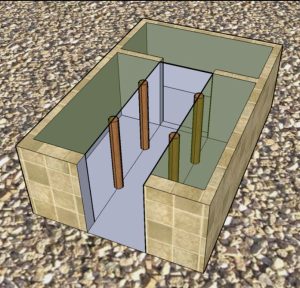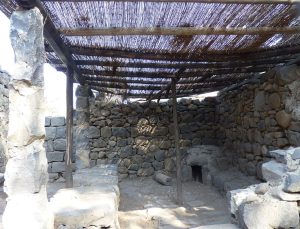The last of the Bavas has arrived! We have made it through laws about damages, lost and found items, loans and rentals and more. In Bava Batra we will largely focus on property – what is included in a land purchase, what do children inherit, as well as many pages about neighbors, shared space and the rights and obligations of people in the same living area. The very first Mishnah dives into this last question:
“MISHNA: Partners who wished to make a partition in a courtyard build the wall in the middle . . .” (Bava Batra 2a)
The shared courtyard, the חצר, will become a familiar presence over the next few months. So let’s take a look at this style of building and its uses.
The idea of building homes around a shared open space is an ancient one. The very first courtyards in the world were discovered in the prehistoric town of Shaar HaGolan, a place that dates back to the Yarmukian culture of 6500 BCE. After that there was no turning back. There are many advantages to building houses around an open space. The outside walls of the homes create a barrier, keeping out unwanted people. On the inside, you have lots of space, a commodity that was absent in most homes before the modern period (and still today in many places). Instead of using precious space for cooking, laundering and hanging out, those activities were outsourced to the courtyard.

Drawing of Shaar HaGolan courtyards
Yosef Garfinkel, CC BY-SA 3.0 <https://creativecommons.org/licenses/by-sa/3.0>, via Wikimedia Commons
It wasn’t only about the space. Ancient homes rarely had glass for windows so you might have had a few openings cut high in the wall, but most homes had little air and light. Cooking in them would have been suffocating, there was no indoor water source for laundry and in general it was almost always more pleasant outside, in the shade. Indoor spaces were for storage, sleep and inclement weather, which in our region is relatively infrequent.
In Biblical times, the family home was built around an inner courtyard. The classic Israelite building was a four-room house:

Digital reconstruction of a four-room house
זנגביל, Public domain, via Wikimedia Commons
Three rooms surrounded a fourth, which was open to the sky. This was a great way to have light and air, but also privacy. We find these four-room houses wherever Israelites lived: Tel Sheva, Tel Megiddo, Tel Kasile and many more. There are even supersized versions that were meant for royalty or as administrative buildings, like the structure discovered at the back of the Western Wall plaza in Jerusalem.
Some scholars suggest that there was something inherently Israelite about the four-room house design. Professor Avi Faust explains that because all rooms can be reached from the courtyard, no one has to pass through anyone else’s room en route to his or her own. This means that there are no better or worse rooms (assuming they are all the same size). It also means that a menstruating woman can be in her own room with access to the courtyard and no one else has to enter her room and become impure. Equality and purity, two important Jewish principles.
By Second Temple times the idea of the courtyard had expanded. Instead of one small home with its own inner courtyard, now you would find a number of small homes that themselves surround a courtyard, creating a mini-neighborhood. At first the homes were populated by members of an extended family, a situation we see described in this Mishnah in Eruvin:
“brothers who were eating at their father’s table and sleeping in their own houses [in the same courtyard,]” (Mishnah Eruvin 6:7)
However, as time passed, some courtyards came to be populated by unrelated neighbors; sometimes even by neighbors who were not Jewish:
“One who resides with a gentile in courtyard, or with one who does not accept the principle of eiruv,” (Mishnah Eruvin 6:1)
It’s hard enough to live in close proximity to your relatives, imagine having to share a rather intimate space with strangers. This is where the many rules and regulations of Bava Batra try to solve the conflicts that may arise.
The courtyard comes up in halacha in different realms. We first encountered it when discussing carrying on Shabbat. There we learned that unrelated members of the hatzer need to create a simulation of living in one happy unit. This is called the eiruv hatzerot, where they set aside food that could potentially be shared by all of them, uniting them into one extended family. If their courtyard is considered one household, they are allowed to carry in it.
Another ruling connected to the courtyard is connected to purchasing, kinyan. A hatzer can acquire an item for someone, for example, a get thrown into the courtyard of a woman. As it is her property, she has acquired it even though it was not handed to her. Finally we have all of the obligations and rights of neighbors that our tractate discusses with in detail.
Archaeologists have uncovered many courtyard neighborhoods in excavations around Israel. In the Talmudic Village in Katzrin, in the Golan, they have taken the actual houses they found and added reconstructed tools, ladders, beds and more to give a sense of what a home and courtyard might look like. Standing there one can easily understand how everyone knew what was being cooked for your dinner and why people might complain about the noise others make:
“a store in his courtyard, his neighbor can protest and say to him: I am unable to sleep due to the sound of people entering the store and the sound of people exiting.” (Mishnah Bava Batra 2:3).

The reconstructed courtyard in Katzrin
Ricardo Tulio Gandelman from Rio de Janeiro, Brazil, CC BY 2.0 <https://creativecommons.org/licenses/by/2.0>, via Wikimedia Commons
Courtyards remained the common way to build into early modern times. If you visit the old Jerusalem neighborhoods of Nahlaot they are all built around large courtyards. Old timers from these neighborhoods will reminisce about how that was where life took place – laundry, cooking, kids playing, peddlers hawking their wares and general hanging out. The Old City in Jerusalem also has many spaces like this and one has been turned into a museum that shows life in the Jewish Quarter before 1948: The Old Yishuv Court Museum.

Laundry in the Old Yishuv courtyard
Deror_avi, CC BY-SA 3.0 <https://creativecommons.org/licenses/by-sa/3.0>, via Wikimedia Commons
Today architects and urban planners looking for ways to create community in cramped city spaces are turning back to the courtyard. But will they have to arbitrate between neighbors as well?










